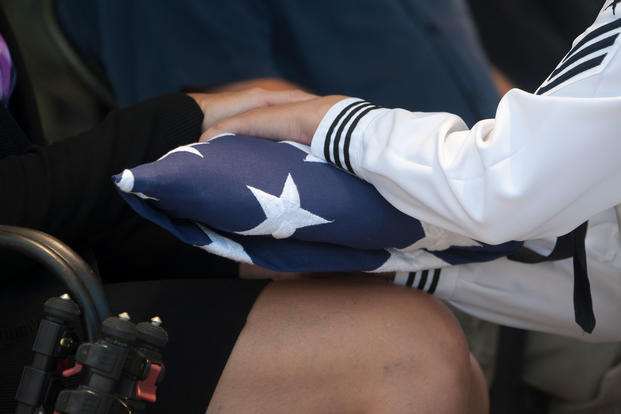A photo of an Army widow and her soldier, casket open, posted to Twitter with a message decrying the #TakeaKnee controversy. A portrait of fallen soldier and former NFL player Pat Tillman, shared to remind us that he did sacrifice.
Pulled into memes or social media posts, these pictures of the fallen and others like them may be born out of good intentions and meant to remind us to support the troops over celebrities and patriotism over politics. And they are shared again and again by well wishers, military supporters and, yes, even President Donald Trump.
The problem? The families are pushing back. And we cannot blame them.
Like the veteran community, the Gold Star community often defies stereotype. Seana Arrechaga, whose husband, Army Sgt. 1st Class Ofren Arrechaga, was killed in 2011, has asked that a photo of her at his memorial not be used to "stifle free speech."
Marie Tillman has asked that her husband's death not be politicized.
The conflict shines a light on a complex issue with no easy solution: in an age of social media, where photos speak louder than words, how do we balance honor with respect?
I never thought I would be a part of the problem.
As a part of its public affairs program, the Defense Department publishes photos to a media repository. Families of the fallen can ask that images from memorials not be shared there. Those that are posted are free for anyone to use.
As an editor and a military family member, the decision to use a photo from the family of the fallen is both a technical and a moral one. Does the image fit the story and convey the feeling I'm trying to share? And would I, as a military family member, want my photo used in this way? As long as I can answer "yes" to both of those questions, I use the photo.
That's why I carefully and confidently picked a photo of a woman at a military memorial for a story decrying a Hollywood decision to seek out military widows for a Bachelorette-style reality show. I selected a photo, several years old, that did not show the mourner's face or even reveal her identity, but still conveyed the depth of feeling I was trying to share with the story.
Since it was on the DoD site, I knew that the family had given their permission for it to be used. My job was to use it in the appropriate way. I thought I had.
But then I started to receive emails and messages from the family of the fallen service member and their former casualty affairs officer (CAO). The photo's use was hurtful and upsetting, they said. They wanted it taken down immediately.
Although I had no way to know it, the woman pictured was the sister of the fallen service member. And even though the family had given permission for the photo to be free for any use, they did not want it used in the way I had chosen to use it.
I was mortified. Not only had I failed at what I was trying to do -- write a blog post defending the military widow community -- but I had hurt the family of a fallen service member in the process. I removed the photo as soon as I could and apologized profusely to the family, the soldier's father and the CAO.
It's easy to assume families of the fallen feel one way or another about any given political issue. It's easy to think that, yes, of course they appreciate your effort, of course they want their loved one shared and seen.
But as we look to defend their honor, we risk breaking open old wounds. And, worse, we could be doing a disservice to the fallen themselves. Assumptions hurt. Who are we to know why a service member fought or what any military family member thinks?
For myself, I've added a new question to my military memorial photo litmus test: if the person pictured were to recognize him or herself in the image -- even if their face is hidden, even if no one else knows it's them -- am I certain they would be happy with my decision to use it?
If the answer is "no," I move on.
I suggest you do the same.










